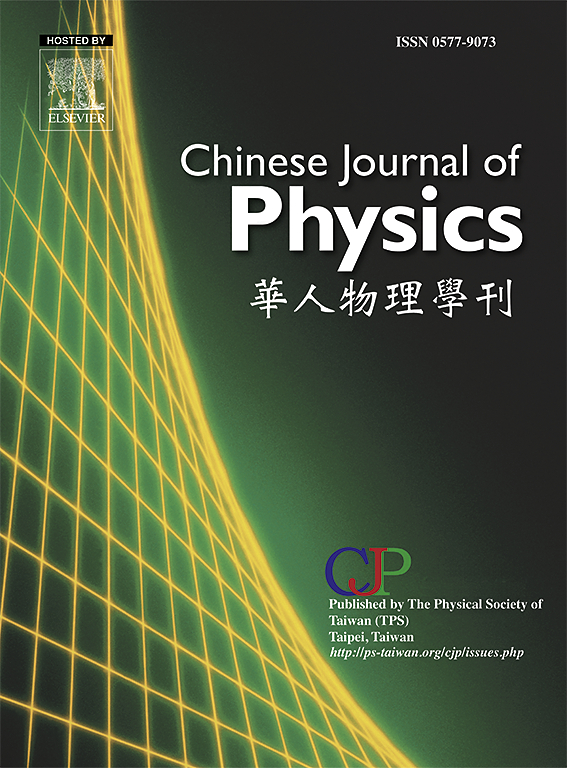Pressure induced high-Tc superconductivity in ternary SrBH8 with distinctive B–H motif and complex hydrogen bonding patterns
IF 4.6
2区 物理与天体物理
Q1 PHYSICS, MULTIDISCIPLINARY
引用次数: 0
Abstract
Inspired by the recent discovery of near or even above room-temperature superconductors in the pressurized HS, CaH, YH, LaH, and CeH, H-rich hydrides under high pressure are believed to be the potential candidates for high-temperature superconductors. Unfortunately, the tremendous pressures needed to stabilize these structures exceptionally restrict their practical applications. An effective strategy to reduce the external pressure is to incorporate the light boron atom into established binary hydrides to construct binary B–H textures with the B–H covalent bonds. Guided by this hypothesis, crystal structures and superconductivity of ternary Sr-B-H system under pressure were theoretically delved into. Notably, we successfully identify a stable SrBH8 under 137–300 GPa and the triclinic P-1-SrBH8 phase can be retained to at least 137 GPa during decompression. Subsequently, trigonal R-3m-SrBH8 becomes more stable than P-1-SrBH8 at 212 GPa. Intriguingly, P-1-SrBH8 consists of the BH4 framework and H2 molecular dimer while R-3m-SrBH8 encompasses the BH6 motif and H4 unit. Namely, despite the H atom bonding mode bonded to B atom in BH4 and BH6 units in both phases is same with robust B–H covalent bond, the remanent H atom bonding modes are distant, which denotes the H2 unit with the H2–H2 covalent bond and weak H1–H2 covalent bond in the H4 texture emerge in P-1-SrBH8 and Rm-SrBH8, respectively. Both crystals are predicted to be promising superconductors with the estimated T s of 103 K (P-1-SrBH8, 137 GPa) and 141 K (Rm-SrBH8, 300 GPa), which are separately attributed to the vibration of the B–H bond in BH4 framework, and a hybrid vibration of the B–H bond in BH6 building and the H1–H2 bond in H4 unit. This work provides an effective strategy for the design of the low-pressure stabilized high-temperature hydride superconductors, which is destined to widen the explorations on the particular B–H skeleton and abundant H bonding mode in the H-rich ternary borohydrides.

具有独特的B-H基序和复杂氢键模式的三元SrBH8的压力诱导高tc超导性
受最近在高压H3S、CaH6、YH9、LaH10和CeH18中发现的接近甚至高于室温的超导体的启发,高压下的富h氢化物被认为是高温超导体的潜在候选者。不幸的是,稳定这些结构所需的巨大压力特别限制了它们的实际应用。将轻硼原子掺入已建立的二元氢化物中,构建具有B-H共价键的二元B-H织构是降低外部压力的有效策略。在这一假设的指导下,从理论上深入研究了高压下Sr-B-H三元体系的晶体结构和超导性。值得注意的是,我们成功地鉴定了一个在137 - 300 GPa下稳定的SrBH8相,并且在减压过程中,三斜的P-1-SrBH8相可以保持在至少137 GPa。随后,三角形R-3m-SrBH8在212 GPa时变得比P-1-SrBH8更稳定。有趣的是,P-1-SrBH8由BH4框架和H2分子二聚体组成,而R-3m-SrBH8包含BH6 motif和H4单元。即,尽管两相中BH4和BH6单元中H原子与B原子的键合模式相同,具有较强的B - H共价键,但剩余的H原子键合模式较远,这表明P-1-SrBH8和R - 3m-SrBH8中分别出现了H4织构中具有H2 - H2共价键和弱H1-H2共价键的H2单元。这两种晶体的tcs分别为103 K (P-1-SrBH8, 137 GPa)和141 K (R - 3m-SrBH8, 300 GPa),分别归因于BH4框架中B-H键的振动,以及BH6结构中B-H键和H4单元中H1-H2键的混合振动。本研究为低温稳定高温氢化物超导体的设计提供了一种有效的策略,这必将拓宽对富氢三元硼氢化物中特定的B-H骨架和丰富的氢键模式的探索。
本文章由计算机程序翻译,如有差异,请以英文原文为准。
求助全文
约1分钟内获得全文
求助全文
来源期刊

Chinese Journal of Physics
物理-物理:综合
CiteScore
8.50
自引率
10.00%
发文量
361
审稿时长
44 days
期刊介绍:
The Chinese Journal of Physics publishes important advances in various branches in physics, including statistical and biophysical physics, condensed matter physics, atomic/molecular physics, optics, particle physics and nuclear physics.
The editors welcome manuscripts on:
-General Physics: Statistical and Quantum Mechanics, etc.-
Gravitation and Astrophysics-
Elementary Particles and Fields-
Nuclear Physics-
Atomic, Molecular, and Optical Physics-
Quantum Information and Quantum Computation-
Fluid Dynamics, Nonlinear Dynamics, Chaos, and Complex Networks-
Plasma and Beam Physics-
Condensed Matter: Structure, etc.-
Condensed Matter: Electronic Properties, etc.-
Polymer, Soft Matter, Biological, and Interdisciplinary Physics.
CJP publishes regular research papers, feature articles and review papers.
 求助内容:
求助内容: 应助结果提醒方式:
应助结果提醒方式:


